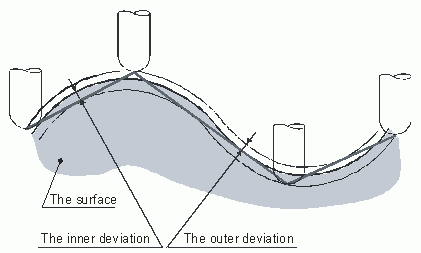Tolerance
Machining tolerance is assigned in the system by the maximum deviations of the approximated tool movement toolpath from the ideal one.
< Outer deviation > defines the maximum allowed tool deviation away from the surface of the detail being machined (inwards to the tool).
< Inner deviation > defines the maximum allowed cutting of the tool into the detail being machined (outwards from the tool).
For deviation from the detail, the positive direction is outwards from the detail surface (inwards to the tool), and negative for deviation into the detail (outwards from the tool). Thus, the machining tolerance is equal to the sum of deviations outside and inside the detail. One should note that increasing the tolerance (decreasing the sum of deviations) would increase the calculation time and the size of the NC program. And vice versa, the higher the sum of the deviations inside and outside the detail, the more rough will be the toolpath. The sum of the deviations must be more than zero, otherwise it will be impossible to construct an approximated toolpath.
In most cases it is more convenient to assign deviations inside the detail equal to zero, and outside the detail equal to the desired machining tolerance. With these parameters, the minimal thickness of the remaining material layer will be equal to the defined stockstock. If deviation inside the detail is not zero, then the thickness of the remaining material layer will be less than the defined stock equal to the deviation inside the detail value.
Note : It is recommended to enter positive deviation and stock values.
Maximum deviations can be defined in the < Parameters > < Parameters > page.

See also: